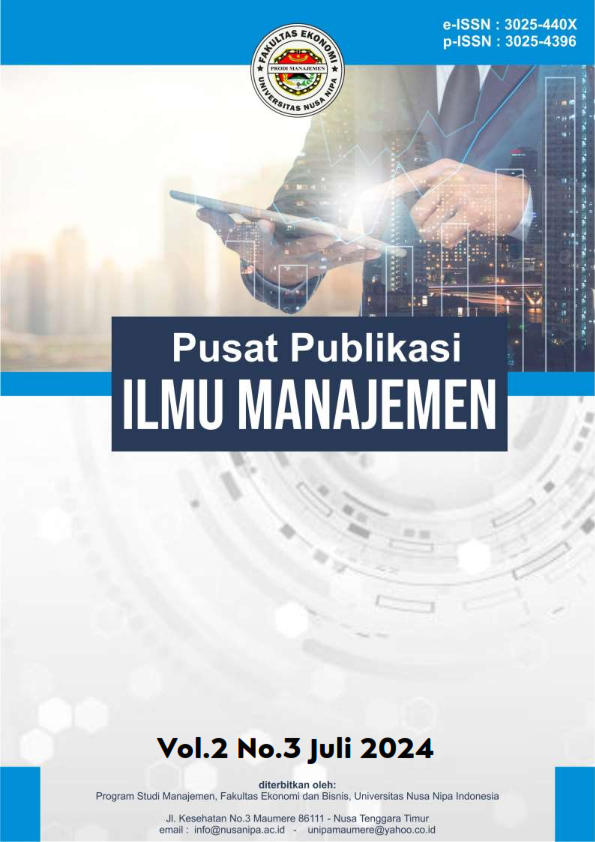Peran Aksesibilitas dan Pengalaman Dalam Niat Berkunjung Kembali di Siola Surabaya
DOI:
https://doi.org/10.59603/ppiman.v2i3.404Keywords:
Accessibility, visitor experience, intention to visit again, Siola SurabayaAbstract
This research aims to examine the role of accessibility and visitor experience on intentions to return to Siola Surabaya. Siola, as one of the iconic shopping and cultural centers in Surabaya, always tries to increase its attractiveness through various infrastructure and service improvements. The research results show that good accessibility and positive experiences significantly influence revisit intentions.
References
Alexandris, K., Kouthouris, C., & Meligdis, A. 2006. Increasing customers' loyalty in a skiing resort: The contribution of place attachment and service quality. International Journal of Contemporary Hospitality Management, 18(5), 414-425.
Ariesta, D., Sukotjo, E., & Suleman, N.R. 2020. The Effect of Attraction, Accessibility and Facilities on Destination Images and Its Impact on Revisit Intention in the Marine Tourism of the Wakatobi Regency. International Journal of Scientific & Technology Research, 9(3).
Beeho, A. J., & R. C. Prentice. 1997. Conceptualizing The Experiences of Heritage Tourists: A Case Study of New Lanark World Heritage Village. Tourism Management, 18(2), 75–87.
Boes, K., Buhalis, D., & Inversini, A. 2015. Conceptualising Smart Tourism Destination Dimensions. Information and Communication Technologies in Tourism 2015, February, 391–403.
Cronin Jr, & Taylor, S. A 1992. Measuring service quality: a reexamination and extension. Journal of Marketing, 56(3), 55-68.
Chi, C. G., & Qu, H. 2008. Examining the structural relationships of destination image, tourist satisfaction and destination loyalty: An integrated approach. Tourism Management, 29(4), 624-636.
Chang, L. L., Backman, K. F., & Huang, Y. C. 2014. Creative tourism: a preliminary examination of creative tourists’ motivation, experience, perceived value and revisit intention. International Journal of Culture, Tourism, and Hospitality Research, 8(4), 401–419.
Edwards, D., Griffin, T., & Hayllar, B. 2008. Urban Tourism Research. Annals of Tourism Research, 35(4), 1032–1052.
Gomez-Jacinto, L., J. S. Martin-Garcia, & C. B. Huyze. 1999. A Model of Tourism Experience and Attitude Change. Annals of Tourism Research, 26(4), 1024-1027.
Geurs, K., Boon, W., Van Wee, B., 2009. Social impacts of transport: Literature review and the state of the practice of transport appraisal in the Netherlands and the United Kingdom. Transp. Rev. 29 (1), 69–90.
Hall, C. M. 2004. Space-time accessibility and the tourist area cycle of evolution: The role of geographies of spatial interaction and mobility in contributing to an improved understanding of tourism,in The Tourism Life Cycle: Conceptual and Theoretical Issues, ed. R. Butl.
Homburg, C., Stierl, M., & Bornemann, T. 2013. Corporate social responsibility in business-to-business markets: How organizational customers account for supplier corporate social responsibility engagement. Journal of Marketing, 77(6), 54–72
Kim, J. H. 2018. The impact of memorable tourism experiences on loyalty behaviors: The mediating effects of destination image and satisfaction. Journal of Travel Research, 57(7), 856-870.
Kuklina, M., Dirin, D., Filippova, V., Savvinova, A., Trufanov, A., Krasnoshtanova, N., Bogdanov, V., Kobylkin, D., Fedorova, A., Itegelova, A., & Batotsyrenov, E. 2022. Transport Accessibility and Tourism Development Prospects of Indigenous Communities of Siberia. Sustainability, 14(3), 1750
Lee, J., Choi, Y., & Breiter, D. 2016. An exploratory study of convention destination competitiveness from the attendees’ perspective: Importance-performance analysis and repeated measures of Manova. Journal of Hospitality & Tourism Research, 40(5), 589–610.
Morgan, D. J., & Lok, L. 2000. Assessment of a comfort indicator for natural tourist attractions: The case of visitors to hanging rock, victoria? Journal of Sustainable Tourism, 8(5), 393–409.
Medlik, s. 2003. Dictionary of Travel, Tourism and Hospitality (3rd ed.). Butterworth-Heinemann.
Mammadov, R. 2012. The Importance of Transportation in Tourism Sector. 7th Silk Road International Conference “Challenges and Opportunities of Sustainable Economic Development in Eurasian Countries,” 381–386.
Porto, N., Rucci, A.C., & Ciaschi, M. 2018. Tourism Accessibility Competitiveness. A Regionalapproach for Latin American Countries. Nvestigaciones Regionales , 75–91.
Piramanayagam, S., Sud, S., and Seal, P. 2020. Relationship between tourist local food experiencesscape, satisfaction and behavioural intention. International Journal of Tourism and Hospitality Research, 31(2), 316-330.
Schmitt, B. H. 1999. Experiential Marketing: How to Get Customers to Sense, Feel, Thank, Act and Relate to Your Company and Brands. The Free Press: New York.
Santana, M.‐J. D., Beerli‐Palacio, A., and Nazzareno, P. A. 2017. Antecedents and consequences of destination image gap. Annals of Tourism Research, 62, 13-25.
Schmitt, B. H. 2019. The Current State & Future of Brand Experience. Journal of Brand Management. Volume. 21 NO. 16, pp. 727-733.
Sugiama, A.G., Nurhikmah, W., Rini, R.O.P., & Wigati, E. 2023. Investigating the Essence of Recreational Accessibility and Its Effects on Satisfaction, Memories, and Loyalty of City Park Visitors. African Journal of Hospitality, Tourism and Leisure, 12(4), 1524–1541.
Zeithaml, V. A., Bitner, M. J., & Gremler, D. D. 2018. Services Marketing Integrating Customer Focus Across the Firm. New York: McGraw-Hill Education.
Additional Files
Published
How to Cite
Issue
Section
License
Copyright (c) 2024 PPIMAN Pusat Publikasi Ilmu Manajemen

This work is licensed under a Creative Commons Attribution-ShareAlike 4.0 International License.






